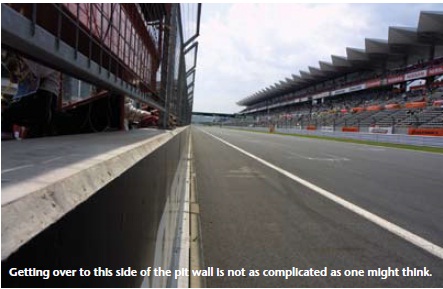by Len Clarke, RACENOW Japan Director
The ever-increasing number of high-performance vehicles on Tokyo’s streets begs the question; do the owners ever get the chance to really push the limits of their chariots of choice? And if given the opportunity, how would they fare?
While for some, the reason for owning such a machine is purely aesthetic; others are inspired by what it (and its driver) can do.
Getting your road car onto one of Japan’s many racing circuits is a little easier than you might imagine and with so many other things in Japan, not only are there facilities available for would-be racers to test their skills, the problem is choosing which venue to visit.
Fortunately for Tokyoites, by far the most advanced racing facility in the country is also the closest. Fuji Speedway, famous for hosting the first-ever Japanese Grand Prix back in 1976 and 1977, underwent a total rebuild in 2004, reopening as the country’s only FIA Grade 1 circuit in the spring of 2005. The grade 1 certification means a host of high-tech firsts including a gradient of less than one mm for every two meters—making for an incredibly smooth (and fast) ride.
Far more than just the Grand Prix circuit, the facility also hosts a wide variety of activities for road car users at its Toyota Safety Education Center ‘mobilitas’. There is also a separate 920-meter short track that can be configured 16 different ways, providing new thrills every time. In addition, a drift course has been added to cater to the tastes of Japan’s latest motoring craze.
Getting out on track
Naturally, you can’t just show up and expect to be allowed to take your car onto any racing circuit; there are a number of steps that must be taken before getting the green light.
Fuji Speedway’s ‘How to Run’ program is a six-step course that allows even the most novice driver to acclimatize to driving on a racetrack and make the most of the experience in the car. In the first step, you follow an instructor’s car around the circuit, copying the driving line. This is followed by the ‘License’ stage, a twoand- a-half hour classroom session covering everything from on-track manners to first aid and emergency situation management. The license allows one to drive at Fuji Speedway’s facility only; it is not transferable to other circuits. The next stage is where participants prepare for the all-important racing license. Driving on a circuit is one thing, fighting others for position on track is quite another. Here again, a variety of options are available, everything from club event licenses to professional one-make race certificates. Once you’ve completed the process, you’re ready to race!
For those who’d rather not go through the process but want to get out on track anyway, there’s the ingenious ‘Circuit Taxi’—where a professional racing driver will take you around at speed. The cost: ¥3,000 for two laps of the 4.563-km track. Highly recommended, it’s a memorable experience for even the hardest of racing fans.
The circuit:
Fuji Speedway originally opened in 1966, during Japan’s heyday of motorcycle and saloon car racing. The track still boasts the longest straight of any circuit in use today at 1.5 kilometers (almost a mile). What this means of course is that by the time cars get to the end of that long uninterrupted piece of tarmac, they’re absolutely flying! When Formula One visits September 28–30 (after an absence of 30 years), estimated speeds for the top cars are expected to be in the region of 330km/h (over 200 mph) as they prepare to negotiate Turn 1.
Events at Fuji Speedway:
All the top Japanese racing series: SUPER GT, Formula Nippon, Japanese Formula 3, JLMC (Japan Le Mans Challenge), and Super Taikyu visit the circuit for one or two rounds every season; so if you’re a racing fan, there’s really no excuse for not heading out at least once.
We’re already at the halfway point of the motor racing season in Japan and the next few months have a variety of great events on hand.
Over the first weekend in August (4–5), there’s the traditional Super Tec four-hour endurance race, Round four of the Super Taikyu series (www.supertaikyu.com/). S-TAI features mildly modified versions of road-going saloons including the Porsche 911, Nissan Fairlady Z, BMW Z4 Coupe, Subaru Impreza, Mitsubishi Lancer, Honda S2000, BMW M3, and Honda NSX, among others.
Three weeks later (August 25–26), the country’s top-level single-seater series Formula Nippon (www.f-nippon.co.jp/eng), makes its mid- eason return to Fuji. The 22 Lola FN06 chassis, mated to either Toyota or Honda power, provides supremely close racing, creating excitement reminiscent of F1 25 years ago. The season finale for SUPER GT (www.supergt.net/en), by far the nation’s most popular racing championship, comes on November 4–5. Typically, the series points’ battle goes down to the wire, often with half a dozen or more cars being capable of taking the crown at the last race. It is the fastest GT (Grand Touring—twodoor cars with big engines) series in the world, and the only one with three manufacturers actively taking part. For a complete listing of all events at the circuit, go to www.fsw.tv.
Getting there:
By car, it’s as easy as taking the Tomei expressway to Gotemba Interchange, approximately 100 kilometers (60 miles) from the centre of Tokyo. From there, it’s another 15-minute drive to the circuit. The roads are well signposted and there’s an excellent map on the Fuji Speedway website at: www.fsw.tv/english/access/index.html.
By train, take the Odakyu line ‘Asagiri’ express from Shinjuku station, alighting at Gotemba. Bus and taxi service (¥3,000) to the track is readily available.
Questions about motor sport? Email: racenow@ mac.com or visit www.racenowjapan.com.









